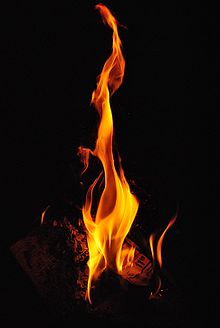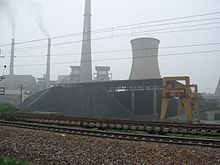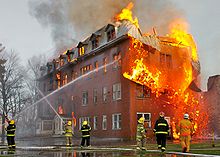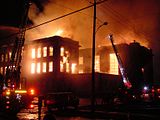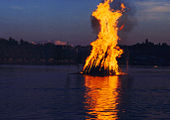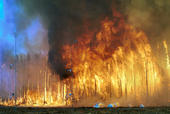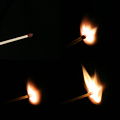- Fire
-
For other uses, see Fire (disambiguation).
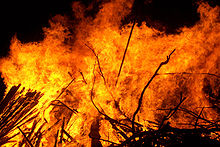 An outdoor fire using wood, termed a bonfire.
An outdoor fire using wood, termed a bonfire. The ignition and extinguishing of a pile of wood shavings.
The ignition and extinguishing of a pile of wood shavings. Slow motion fire sequence 1000 frame/s
Slow motion fire sequence 1000 frame/s
Fire is the rapid oxidation of a material in the chemical process of combustion, releasing heat, light, and various reaction products.[1] Slower oxidative processes like rusting or digestion are not included by this definition.
The flame is the visible portion of the fire and consists of glowing hot gases. If hot enough, the gases may become ionized to produce plasma.[2] Depending on the substances alight, and any impurities outside, the color of the flame and the fire's intensity will be different.
Fire in its most common form can result in conflagration, which has the potential to cause physical damage through burning. Fire is an important process that affects ecological systems across the globe. The positive effects of fire include stimulating growth and maintaining various ecological systems. Fire has been used by humans for cooking, generating heat, signaling, and propulsion purposes. The negative effects of fire include water contamination, soil erosion, atmospheric pollution and hazard to human life.[3]
Contents
Physical properties
Chemistry
Main article: Combustion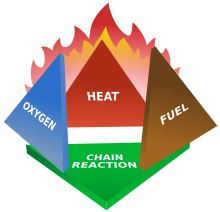 The fire tetrahedron
The fire tetrahedron
Fires start when a flammable and/or a combustible material, in combination with a sufficient quantity of an oxidizer such as oxygen gas or another oxygen-rich compound (though non-oxygen oxidizers exist that can replace oxygen), is exposed to a source of heat or ambient temperature above the flash point for the fuel/oxidizer mix, and is able to sustain a rate of rapid oxidation that produces a chain reaction. This is commonly called the fire tetrahedron. Fire cannot exist without all of these elements in place and in the right proportions. For example, a flammable liquid will start burning only if the fuel and oxygen are in the right proportions. Some fuel-oxygen mixes may require a catalyst, a substance that is not directly involved in any chemical reaction during combustion, but which enables the reactants to combust more readily.
Once ignited, a chain reaction must take place whereby fires can sustain their own heat by the further release of heat energy in the process of combustion and may propagate, provided there is a continuous supply of an oxidizer and fuel.
Fire can be extinguished by removing any one of the elements of the fire tetrahedron. Consider a natural gas flame, such as from a stovetop burner. The fire can be extinguished by any of the following:
- turning off the gas supply, which removes the fuel source;
- covering the flame completely, which smothers the flame as the combustion both uses the available oxidizer (the oxygen in the air) and displaces it from the area around the flame with CO2;
- application of water, which removes heat from the fire faster than the fire can produce it (similarly, blowing hard on a flame will displace the heat of the currently burning gas from its fuel source, to the same end), or
- application of a retardant chemical such as Halon to the flame, which retards the chemical reaction itself until the rate of combustion is too slow to maintain the chain reaction.
In contrast, fire is intensified by increasing the overall rate of combustion. Methods to do this include balancing the input of fuel and oxidizer to stoichiometric proportions, increasing fuel and oxidizer input in this balanced mix, increasing the ambient temperature so the fire's own heat is better able to sustain combustion, or providing a catalyst; a non-reactant medium in which the fuel and oxidizer can more readily react.
Flame
Main article: FlameA flame is a mixture of reacting gases and solids emitting visible, infrared, and sometimes ultraviolet light, the frequency spectrum of which depends on the chemical composition of the burning material and intermediate reaction products. In many cases, such as the burning of organic matter, for example wood, or the incomplete combustion of gas, incandescent solid particles called soot produce the familiar red-orange glow of 'fire'. This light has a continuous spectrum. Complete combustion of gas has a dim blue color due to the emission of single-wavelength radiation from various electron transitions in the excited molecules formed in the flame. Usually oxygen is involved, but hydrogen burning in chlorine also produces a flame, producing hydrogen chloride (HCl). Other possible combinations producing flames, amongst many, are fluorine and hydrogen, and hydrazine and nitrogen tetroxide.
The glow of a flame is complex. Black-body radiation is emitted from soot, gas, and fuel particles, though the soot particles are too small to behave like perfect blackbodies. There is also photon emission by de-excited atoms and molecules in the gases. Much of the radiation is emitted in the visible and infrared bands. The color depends on temperature for the black-body radiation, and on chemical makeup for the emission spectra. The dominant color in a flame changes with temperature. The photo of the forest fire is an excellent example of this variation. Near the ground, where most burning is occurring, the fire is white, the hottest color possible for organic material in general, or yellow. Above the yellow region, the color changes to orange, which is cooler, then red, which is cooler still. Above the red region, combustion no longer occurs, and the uncombusted carbon particles are visible as black smoke.
The National Aeronautics and Space Administration (NASA) of the United States has recently found that gravity also plays a role in flame formation. Modifying the gravity causes different flame types.[4] The common distribution of a flame under normal gravity conditions depends on convection, as soot tends to rise to the top of a general flame, as in a candle in normal gravity conditions, making it yellow. In micro gravity or zero gravity, such as an environment in outer space, convection no longer occurs, and the flame becomes spherical, with a tendency to become more blue and more efficient (although it may go out if not moved steadily, as the CO2 from combustion does not disperse as readily in micro gravity, and tends to smother the flame). There are several possible explanations for this difference, of which the most likely is that the temperature is sufficiently evenly distributed that soot is not formed and complete combustion occurs.[5] Experiments by NASA reveal that diffusion flames in micro gravity allow more soot to be completely oxidized after they are produced than diffusion flames on Earth, because of a series of mechanisms that behave differently in micro gravity when compared to normal gravity conditions.[6] These discoveries have potential applications in applied science and industry, especially concerning fuel efficiency.
In combustion engines, various steps are taken to eliminate a flame. The method depends mainly on whether the fuel is oil, wood, or a high-energy fuel such as jet fuel.
Heat
Main article: HeatFires give off heat, or the process of energy transfer from one body or system due to thermal contact.
Typical temperatures of fires and flames
- Oxyhydrogen flame: 2000 °C or above (3600 °F)[7]
- Bunsen burner flame: 1,300 to 1,600 °C (2,400 to 2,900 °F)[8]
- Blowtorch flame: 1,300 °C (2,400 °F)[9]
- Candle flame: 1,000 °C (1,800 °F)
- Smoldering cigarette:
- Temperature without drawing: side of the lit portion; 400 °C (750 °F); middle of the lit portion: 585 °C (1,100 °F)
- Temperature during drawing: middle of the lit portion: 700 °C (1,300 °F)
- Always hotter in the middle.
Temperatures of flames by appearance
The temperature of flames with carbon particles emitting light can be assessed by their color:[10]
- Red
- Just visible: 525 °C (980 °F)
- Dull: 700 °C (1,300 °F)
- Cherry, dull: 800 °C (1,500 °F)
- Cherry, full: 900 °C (1,700 °F)
- Cherry, clear: 1,000 °C (1,800 °F)
- Orange
- Deep: 1,100 °C (2,000 °F)
- Clear: 1,200 °C (2,200 °F)
- White
- Whitish: 1,300 °C (2,400 °F)
- Bright: 1,400 °C (2,600 °F)
- Dazzling: 1,500 °C (2,700 °F)
Fire ecology
Main article: Fire ecologyEvery natural ecosystem has its own fire regime, and the organisms in those ecosystems are adapted to or dependent upon that fire regime. Fire creates a mosaic of different habitat patches, each at a different stage of succession.[11] Different species of plants, animals, and microbes specialize in exploiting a particular stage, and by creating these different types of patches, fire allows a greater number of species to exist within a landscape.
Fossil record
Main article: Fossil record of fireThe fossil record of fire first appears with the establishment of a land-based flora in the Middle Ordovician period, 470 million years ago,[12] permitting the accumulation of oxygen in the atmosphere as never before, as the new hordes of land plants pumped it out as a waste product. When this concentration rose above 13%, it permitted the possibility of wildfire.[13] Wildfire is first recorded in the Late Silurian fossil record, 420 million years ago, by fossils of charcoalified plants.[14][15] Apart from a controversial gap in the Late Devonian, charcoal is present ever since.[15] The level of atmospheric oxygen is closely related to the prevalence of charcoal: clearly oxygen is the key factor in the abundance of wildfire.[16] Fire also became more abundant when grasses radiated and became the dominant component of many ecosystems, around 6 to 7 million years ago;[17] this kindling provided tinder which allowed for the more rapid spread of fire.[16] These widespread fires may have initiated a positive feedback process, whereby they produced a warmer, drier climate more conducive to fire.[16]
Human control
Main article: Control of fire by early humans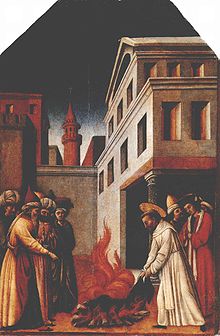 The fire miracle of Saint Peter Martyr by Antonio Vivarini.
The fire miracle of Saint Peter Martyr by Antonio Vivarini.
The ability to control fire was a dramatic change in the habits of early humans. Making fire to generate heat and light made it possible for people to cook food, increasing the variety and availability of nutrients. The heat produced would also help people stay warm in cold weather, enabling them to live in cooler climates. Fire also kept nocturnal predators at bay. Evidence of cooked food is found from 1.9 million years ago, although fire was probably not used in a controlled fashion until 400,000 years ago.[16] Evidence becomes widespread around 50 to 100 thousand years ago, suggesting regular use from this time; interestingly, resistance to air pollution started to evolve in human populations at a similar point in time.[16] The use of fire became progressively more sophisticated, with its being used to create charcoal and to control wildlife from tens of thousands of years ago.[16]
Fire has also been used for centuries as a method of torture and execution, as evidenced by death by burning as well as torture devices such as the iron boot, which could be filled with water, oil, or even lead and then heated over an open fire to the agony of the wearer.
By the Neolithic Revolution,[citation needed] during the introduction of grain-based agriculture, people all over the world used fire as a tool in landscape management. These fires were typically controlled burns or "cool fires",[citation needed] as opposed to uncontrolled "hot fires", which damage the soil. Hot fires destroy plants and animals, and endanger communities. This is especially a problem in the forests of today where traditional burning is prevented in order to encourage the growth of timber crops. Cool fires are generally conducted in the spring and autumn. They clear undergrowth, burning up biomass that could trigger a hot fire should it get too dense. They provide a greater variety of environments, which encourages game and plant diversity. For humans, they make dense, impassable forests traversable.
There are numerous modern applications of fire. In its broadest sense, fire is used by nearly every human being on earth in a controlled setting every day. Users of internal combustion vehicles employ fire every time they drive. Thermal power stations provide electricity for a large percentage of humanity.
 Hamburg after four fire-bombing raids in July, 1943, which killed an estimated 50,000 people.[18]
Hamburg after four fire-bombing raids in July, 1943, which killed an estimated 50,000 people.[18]
The use of fire in warfare has a long history. Fire was the basis of all early thermal weapons. Homer detailed the use of fire by Greek commandos who hid in a wooden horse to burn Troy during the Trojan war. Later the Byzantine fleet used Greek fire to attack ships and men. In the First World War, the first modern flamethrowers were used by infantry, and were successfully mounted on armoured vehicles in the Second World War. In the latter war, incendiary bombs were used by Axis and Allies alike, notably on Tokyo, Rotterdam, London, Hamburg and, notoriously, at Dresden, in the latter two cases firestorms were deliberately caused in which a ring of fire surrounding each city[citation needed] was drawn inward by an updraft caused by a central cluster of fires. The United States Army Air Force also extensively used incendiaries against Japanese targets in the latter months of the war, devastating entire cities constructed primarily of wood and paper houses. The use of napalm was employed in July 1944, towards the end of the Second World War;[19] although its use did not gain public attention until the Vietnam War.[19] Molotov cocktails were also used.
Use as fuel
 Disability-adjusted life year for fires per 100,000 inhabitants in 2004.[20]
Disability-adjusted life year for fires per 100,000 inhabitants in 2004.[20] no dataless than 5050-100100-150150-200200-250250-300300-350350-400400-450450-500500-600more than 600
no dataless than 5050-100100-150150-200200-250250-300300-350350-400400-450450-500500-600more than 600Setting fuel aflame releases usable energy. Wood was a prehistoric fuel, and is still viable today. The use of fossil fuels, such as petroleum, natural gas, and coal, in power plants supplies the vast majority of the world's electricity today; the International Energy Agency states that nearly 80% of the world's power comes from these sources.[21] The fire in a power station is used to heat water, creating steam that drives turbines. The turbines then spin an electric generator to produce electricity. Fire is also used to provide mechanical work directly, in both external and internal combustion engines.
The unburnable solid remains of a combustible material left after a fire is called clinker if its melting point is below the flame temperature, so that it fuses and then solidifies as it cools, and ash if its melting point is above the flame temperature.
Protection and prevention
Main articles: Wildfire and Fire protectionWildfire prevention programs around the world may employ techniques such as wildland fire use and prescribed or controlled burns.[22][23][24] Wildland fire use refers to any fire of natural causes that is monitored but allowed to burn. Controlled burns are fires ignited by government agencies under less dangerous weather conditions.[25]
Fire fighting services are provided in most developed areas to extinguish or contain uncontrolled fires. Trained firefighters use fire apparatus, water supply resources such as water mains and fire hydrants or they might use A and B class foam depending on what is feeding the fire.
Fire prevention is intended to reduce sources of ignition. Fire prevention also includes education to teach people how to avoid causing fires.[26] Buildings, especially schools and tall buildings, often conduct fire drills to inform and prepare citizens on how to react to a building fire. Purposely starting destructive fires constitutes arson and is a crime in most jurisdictions.
Model building codes require passive fire protection and active fire protection systems to minimize damage resulting from a fire. The most common form of active fire protection is fire sprinklers. To maximize passive fire protection of buildings, building materials and furnishings in most developed countries are tested for fire-resistance, combustibility and flammability. Upholstery, carpeting and plastics used in vehicles and vessels are also tested.
Where fire prevention and fire protection have failed to prevent damage, fire insurance can mitigate the financial impact.
Restoration
Different restoration methods and measures are used depending on the type of fire damage that occurred. Fire damage can be performed by property management teams, building maintenance personnel, or by the homeowners themselves; however, contacting a certified professional fire damage restoration specialist is often regarded as the safest way to restore fire damaged property due to their training and extensive experience.[27] Most are usually listed under "Fire and Water Restoration" and they can help speed repairs, whether for individual homeowners or for the largest of institutions.[28]
Fire and Water Restoration companies are regulated by the appropriate state's Department of Consumer Affairs - usually the state contractors license board. In California, all Fire and Water Restoration companies must register with the California Contractors State License Board.[29] Presently, the California Contractors State License Board has no specific classification for "water and fire damage restoration." Hence, the Contractor's State License Board requires both an asbestos certification (ASB) as well as a demolition classification (C-21) in order to perform Fire and Water Restoration work.[30]
See also
- Áed (given name)
- Colored fire
- Combustion
- Cremation
- Deflagration
- Fire (classical element)
- Fire investigation
- Fire lookout (tower)
- Fire pit
- Fire whirl
- Fire worship
- Flame test
- Life Safety Code
- List of historic fires
- List of light sources
- Phlogiston theory
- Pyranoscope
- Pyrokinesis
- Pyrolysis
- Pyromania
- Smoke
- Volcano
Additional images
-
School fire in Aberdeen, Washington
-
Structure fire in New Orleans after Hurricane Katrina
-
A controlled wildfire in Canada
-
A match being ignited
References
- ^ Glossary of Wildland Fire Terminology. National Wildfire Coordinating Group. November 2009. http://www.nwcg.gov/pms/pubs/glossary/pms205.pdf. Retrieved 2008-12-18
- ^ Helmenstine, Anne Marie. "What is the State of Matter of Fire or Flame? Is it a Liquid, Solid, or Gas?". About.com. http://chemistry.about.com/od/chemistryfaqs/f/firechemistry.htm. Retrieved 2009-01-21
- ^ Lentile, et al., 319
- ^ Spiral flames in microgravity, National Aeronautics and Space Administration, 2000.
- ^ CFM-1 experiment results[dead link], National Aeronautics and Space Administration, April 2005.
- ^ LSP-1 experiment results[dead link], National Aeronautics and Space Administration, April 2005.
- ^ "Flame Temperature Measurement". http://scitation.aip.org/getabs/servlet/GetabsServlet?prog=normal&id=PFLDAS000009000008001577000001&idtype=cvips&gifs=yes.
- ^ "Flame Temperatures". http://www.derose.net/steve/resources/engtables/flametemp.html.
- ^ "Pyropen Cordless Soldering Irons" (PDF). http://www.cooperhandtools.com/europe/sales_literature/documents/WellerPyropen_GB.pdf.
- ^ "A Book of Steam for Engineers", The Stirling Company, 1905
- ^ Begon, M., J.L. Harper and C.R. Townsend. 1996. Ecology: individuals, populations, and communities, Third Edition. Blackwell Science Ltd., Cambridge, Massachusetts, USA.
- ^ Wellman CH, Gray J. The microfossil record of early land plants. Philos Trans R Soc Lond B Biol Sci. 2000;355(1398):717–31; discussion 731–2. doi:10.1098/rstb.2000.0612. PMID 10905606.
- ^ Jones, T.; Chaloner, W. (1991). "Fossil charcoal, its recognition and palaeoatmospheric significance". Palaeogeography, Palaeoclimatology, Palaeoecology 97: 39–50. doi:10.1016/0031-0182(91)90180-Y.
- ^ Glasspool Ij, E. D. (2004). "Charcoal in the Silurian as evidence for the earliest wildfire". Geology 32 (5): 381–383. Bibcode 2004Geo....32..381G. doi:10.1130/G20363.1.
- ^ a b Scott, Andrew C.; Glasspool, Ian J.. The diversification of Paleozoic fire systems and fluctuations in atmospheric oxygen concentration. Proceedings of the National Academy of Sciences (PNAS) USA. 2006;103(29):10861–10865. doi:10.1073/pnas.0604090103. PMID 16832054.
- ^ a b c d e f Bowman DM, Balch JK, Artaxo P et al. Fire in the Earth system. Science. 2009;324(5926):481–4. doi:10.1126/science.1163886. PMID 19390038.
- ^ Retallack GJ. Neogene expansion of the North American prairie. PALAIOS. 1997;12(4):380–90. doi:10.2307/3515337.
- ^ "In Pictures: German destruction". BBC News.
- ^ a b "Napalm". GlobalSecurity.org. http://www.globalsecurity.org/military/systems/munitions/napalm.htm. Retrieved 8 May 2010.
- ^ "WHO Disease and injury country estimates". World Health Organization. 2009. http://www.who.int/healthinfo/global_burden_disease/estimates_country/en/index.html. Retrieved Nov. 11, 2009.
- ^ ""Share of Total Primary Energy Supply", 2002; International Energy Agency". http://www.iea.org/statlist/index.htm.[dead link]
- ^ Federal Fire and Aviation Operations Action Plan, 4.
- ^ MSN Encarta. Backburn [cited 2009-07-09].
- ^ UK: The Role of Fire in the Ecology of Heathland in Southern Britain. International Forest Fire News. January 1998;18:80–81.
- ^ SmokeyBear.com. Prescribed Fires [cited 2008-11-21].
- ^ Fire & Life Safety Education[dead link], Manitoba Office of the Fire Commissioner
- ^ US Department of Homeland Security, US Fire Administration Handbook
- ^ Begal, Bill (August 23, 2007). "Restoration With a Capital E-P-A: A Case Study". Restoration & Remediation. http://www.randrmagonline.com/CDA/Archives/BNP_GUID_9-5-2006_A_10000000000000156172. Retrieved 2008-04-11.
- ^ "California Contractors State License Board". State of California. http://www.cslb.ca.gov/. Retrieved 2010-08-29.
- ^ "What You Should Know About Your Water Damage Or Mold Removal Company:". Rapco West Environmental Services, Inc.. http://www.rapcowest.com/water.html. Retrieved 2010-08-29.
Bibliography
- Karki, Sameer (2002) (PDF). Community Involvement in and Management of Forest Fires in South East Asia. Project FireFight South East Asia. http://www.asiaforests.org/doc/resources/fire/pffsea/Report_Community.pdf. Retrieved 2009-02-13[dead link]
- Haung, Kai. 2009. Population and Building Factors That Impact Residential Fire Rates in Large U.S. Cities. Applied Research Project. Texas State University. TXstate.edu
- Lentile, Leigh B.; Holden, Zachary A.; Smith, Alistair M. S.; Falkowski, Michael J.; Hudak, Andrew T.; Morgan, Penelope; Lewis, Sarah A.; Gessler, Paul E.; Benson, Nate C.. Remote sensing techniques to assess active fire characteristics and post-fire effects. International Journal of Wildland Fire. 2006;3(15):319-345.
- Kosman, Admiel: Sacred fire. In: Thu, January 13, 2011.
External links
- How Fire Works at HowStuffWorks
- What exactly is fire? from The Straight Dope
- On Fire, an Adobe Flash-based science tutorial from the NOVA (TV series)
- Early human fire mastery revealed BBC article on archaeological discoveries
- Flames in microgravity[dead link]
- Spiral flames in microgravity
- moebuildingcontrol.co.uk - UK Guidance on fire safety codes and fire engineering
- Smokey Bear - Prevent Wildfires
- Fun Uses with Fire with a Rubens' Tube
Categories:
Wikimedia Foundation. 2010.


